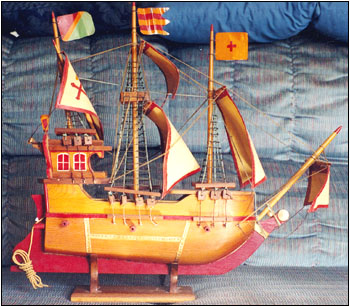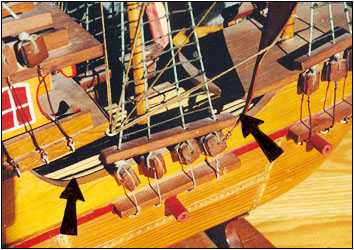Of Old Radios And Related Items--Published Monthly
A Ship Antenna
BY DAVE GONSHORWeb edition
One article frequently leads to another. Unlike the subjects of Dave Crocker's ship speakers, Dave Gonshor's ship is more than likely an antenna. Infinite variety is a hallmark of our hobby. (Editor)In harmony with the ship speakers in Dave Crocker's article in the October 1999 issue of A.R.C., a similar ship is shown in Figure 1. This ship is not a speaker, however, but is believed to be an antenna. Similar to the miniature ship model speakers illustrated in Dave's article, this ship is the same style as the mighty galleons that sailed the seas and discovered America in 1492. I do not know the name of the ship.
Figure 1. The wooden ship model that in reality is a radio antenna.
ConstructionThe construction of the ship is excellent. The hull is made of wood and the sails of a light canvas. The rigging is made of heavy cord, and the ship details are hand-painted. The flags are metal. Construction is done via wood screws or small nails.
The ship measures 22" high x 25" long x 9.5" wide, so it is approximately the same dimensions of the ship speakers sold by Miniature Ship Models. There are no markings identifying the maker, builder, or kit supplier (if, indeed, it is a kit).
The Antenna
Figure 1 also shows the ship's antenna. Approximately 20 feet of No. 18-gauge wire, consisting of ten turns of wire, is strung inside the hull. The wire is stranded copper. The coil of wire has one end protruding from the stern of the ship. Figure 2 shows a detail of the wire wound within the length of the hull (see arrows). The wire was obviously placed there during construction.
It is not clear how effective this ship is as an antenna. A good shortwave or broadcast antenna should be straight and long (tens of feet). A coil of wire would have been appropriate for a superhet of the early-to-mid 1920s, but the wire in this ship has only one connection, so it was not used as a loop antenna.
Figure 2. A close-up view of the ship model with arrows showing the antenna wire strung inside the hollow hull.
If this ship was intended to operate as a radio antenna, then what else might be found out there? We already know the Majestic Melody Cruiser radio and the ship speakers. Perhaps a ship battery or a ship amplifier? Yet another reason to hit the antique shops and see what turns up.(Dave Gonshor, 7121 S. Jellison St., Littleton, CO 80128)
Dave Gonshor, a registered professional electrical engineer, has been collecting radios for about five years. He enjoys battery sets, 1930s tombstones, cathedrals and consoles because of the more interesting electrical restoration they require.
| [Free Sample] [Books, etc., For Sale] [Subscribe to A.R.C./Renew] [Classified Ads] [Auction Prices] [Event Calendar] [Links] [Home] [Issue Archives] [Book Reviews] [Subscription Information] [A.R.C. FAQ] URL = http://www.antiqueradio.com/gonshor_shipantenna_02-00.html Copyright © 1996-2000 by John V. Terrey - For personal use only. Last revised: January 26, 2000. For Customer Assistance please contact ARC@antiqueradio.com or call (978) 371-0512 Pages designed/maintained by Wayward Fluffy Publications
Antique Radio Classified |

